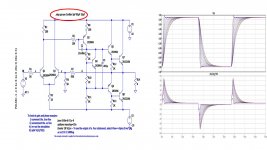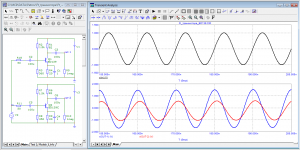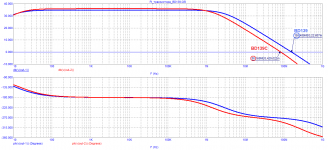This is a picture of the difference the voltage between the inverting and non-inverting inputs of the LTspice amp in the Examples folder in response to stepping Cmiller from 5pF to 95pf in 10pF increments.
You can see the amp goes from partially stable to stable, while the overshoot (magnitide and length) increases as you increase Cdom. The closed loop bandwidth also decreases as Cmiller is increased.
The 1st cycle delay is really just the loop response phase shift because the 2nd stage of the amp is an integrator. Once the loop compensation is optimised (10 to 20pF in this case) you have the lowest phase difference between the input and feedback signal consistent with stable operation.
So IMV, 1st 'cycle distortion' is just about getting the amplifier feedback loop stable consistent with the required bandwidth (and there's a big variation there because designers have different views). The loop bandwidth ultimately has to obey the laws of physics and that means there will be a phase shift around the loop - its not any kind of distortion.
You can see the amp goes from partially stable to stable, while the overshoot (magnitide and length) increases as you increase Cdom. The closed loop bandwidth also decreases as Cmiller is increased.
The 1st cycle delay is really just the loop response phase shift because the 2nd stage of the amp is an integrator. Once the loop compensation is optimised (10 to 20pF in this case) you have the lowest phase difference between the input and feedback signal consistent with stable operation.
So IMV, 1st 'cycle distortion' is just about getting the amplifier feedback loop stable consistent with the required bandwidth (and there's a big variation there because designers have different views). The loop bandwidth ultimately has to obey the laws of physics and that means there will be a phase shift around the loop - its not any kind of distortion.
Attachments
Nattawa, could you show me where the models from Keantoken can be viewed? I've seen Bob Cordell's models.Replaced the transistors with models improved by Bob Cordell for the small and medium power transistors, and models improved by fellow member keantoken (if I recall correctly) for the output transistors, the 10dB gain margin is not there anymore, and the amp turns into an oscillator too.
In your sine burst test, they occur at the beginning and nowhere else, unless you generate the test signal by means of a square wave or with other discontinuities of functions that are identical to them in the essence of their impact. Why should the amplifier, in your opinion, be overloaded if there is a filter at the input? Its input signal increases smoothly after the filter, and the source of the signal has a limited output spectrum.At the beginning of the signal, there are distortions associated with transient processes that depend on the behavior of the group delay. These processes are often called linear only because they do not depend on the signal level, but this does not make the signal any easier. In fact, linear distortion occurs only after the end of the transients.
Graham did not even find such a term as "linear distortion" in the reference book, he found only "linearity", but this is not the same thing!
Unlike Graham, I've found more than one definition for you, but you're still using this argument for no apparent reason. And at the same time, you claim that linear distortion is responsible for the sound quality. And I, for example, can just as well say that the sound quality is related to the number of alien coded signals received in the amplifying channel, which saturate the sound and it becomes more accurate. The more wideband an amplifier is, the more of these signals it can amplify and deliver to the listener. How do you like the theory?
Before you argue, you should agree on the terminology. Give a complete and competent definition of the term "speed distortions" from your point of view and how they differ from other types of distortions already known to science.What is usually measured using Audio Precision refers to nonlinear distortion and can have a negligible level, while the speed distortion, which devices do not measure, can be tens and hundreds of times higher - they are responsible for the sound quality.
Then they are surprised - THD = 0.01%, and the sound is disgusting
nattawa, do you know about the coordination of cascades? so why don't you?
petr, don't bother trying to powder it up to make it look good in a hurry. Once I have found why your simulation did not give you an oscillator, I don't mind it being stable or not anymore. And, "the coordination of cascades", that shows you know too little about the people in this forum for you to "lecture" to, is not a fix to the poor transistor models.
Nattawa, could you show me where the models from Keantoken can be viewed? I've seen Bob Cordell's models.
Hi fagos, you can find the models here:
Keantoken 2SC5200/A1943 Models
This is a picture of the difference the voltage between the inverting and non-inverting inputs of the LTspice amp in the Examples folder in response to stepping Cmiller from 5pF to 95pf in 10pF increments.
You can see the amp goes from partially stable to stable, while the overshoot (magnitide and length) increases as you increase Cdom. The closed loop bandwidth also decreases as Cmiller is increased.
The 1st cycle delay is really just the loop response phase shift because the 2nd stage of the amp is an integrator. Once the loop compensation is optimised (10 to 20pF in this case) you have the lowest phase difference between the input and feedback signal consistent with stable operation.
So IMV, 1st 'cycle distortion' is just about getting the amplifier feedback loop stable consistent with the required bandwidth (and there's a big variation there because designers have different views). The loop bandwidth ultimately has to obey the laws of physics and that means there will be a phase shift around the loop - its not any kind of distortion.
Neat. And a clear, comprehensive explanation of what goes on. No surprises.
Jan
Thanks. I'll read it with interestHi fagos, you can find the models here:
Keantoken 2SC5200/A1943 Models
@jan - yes that's the simple explanation. If you look at the LTP output current in R2 you see it peaks higher and higher as Cmiller in increased but only in response to the rising/falling edges as would be expected. But on the flat top/bottom, there is no difference in current output with change in Cmiller - also as expected since the DC gain is the same no matter what the compensation cap. So the first phase is simply the loop responding to the 2nd stage integrator rate - longer the slower the slope.
(I think Bruno covered this in his F word paper but from a slightly different angle and with math of course)
(I think Bruno covered this in his F word paper but from a slightly different angle and with math of course)
Yes Bruno made the exact same point is different terms. His comparison on 'fast' and 'slow' amps should be mandatory reading for any serious audio diy-er aspiring to design his own stuff.
Jan
Jan
Which model do you think is closer to reality? As the saying goes, "not always in the barn what is written on it."It's common knowledge that a simulation at best is only as good as the models are. It's hard to believe all the "enlightenment" you've been relentlessly preaching are based on simulation works of such poor quality and negligence. So please convince me not to believe.
Attachments
Which model do you think is closer to reality? As the saying goes, "not always in the barn what is written on it."
Why don't you do your own research and find the answer, not only about that one model, but also about all the transistor models you ever used?
nattawa, if you do the nonsense that you suggest, then life is not enough. You're not paying attention to that. The essence of Graham's idea is different and he proved it in practice with his GEM amplifier
The same transistors are made by many manufacturers and they all differ in parameters from each other. You suggest that I develop my own model for each transistor.
The same transistors are made by many manufacturers and they all differ in parameters from each other. You suggest that I develop my own model for each transistor.
Last edited:
petr, so far two things about your "work" seemed to have been clear, 1) the discovery/invention of so-called "first cycle distortion" that you have been preaching has been shown to all, repeatedly, to be nothing more than usual behavior of a feedback amplifier that has been well understood and anticipated. Latest elaboration being
this post by Bonsai
maybe I should've posted that link 20 times back-to-back to help you get a grip of it?
2) the simulations that you posted in support of your real nonsense were based on transistor models some of which evidently proven to be far from what the devices are, therefore, not to be taken without ample amount of salt.
this post by Bonsai
maybe I should've posted that link 20 times back-to-back to help you get a grip of it?
2) the simulations that you posted in support of your real nonsense were based on transistor models some of which evidently proven to be far from what the devices are, therefore, not to be taken without ample amount of salt.
nattawa, Graham also did "nonsense" convincing his colleagues that he was right. How many times should you insert the circuit of his GEM amplifier here so that you understand that he was right? Moreover, the amplifier is repeatedly made in hardware (only optimized in the simulator) and justifies its purpose with dignity. As far as I understood, people like you also tried to humiliate and insult him. As a result, since 2005, he stopped responding to stupid remarks and started developing the GEM amplifier.
And the bonsai is not looking, let him learn to watch the behavior of the output resistance at different frequencies, including with a choke at the amplifier output as Graham taught
So bonsai still grow and grow to Graham
And the bonsai is not looking, let him learn to watch the behavior of the output resistance at different frequencies, including with a choke at the amplifier output as Graham taught
So bonsai still grow and grow to Graham
Last edited:
This is the point where I start hating this forum.
If anybody would call petr for what he is, he/she would break the forum rules and risk a sanction. Meantime, petr can spew his technical nonsense, insult everybody’s intelligence and education, pull everybody’s leg, without any restrictions and consequences other than making a fool of himself (which he doesn’t seem to care).
The only other options are: a) ignore him; admittedly this is not easy in this pathological case, and b) ask the moderators to close this thread, hoping the “hero” won’t spill his stinkin’ beans elsewhere.
If anybody would call petr for what he is, he/she would break the forum rules and risk a sanction. Meantime, petr can spew his technical nonsense, insult everybody’s intelligence and education, pull everybody’s leg, without any restrictions and consequences other than making a fool of himself (which he doesn’t seem to care).
The only other options are: a) ignore him; admittedly this is not easy in this pathological case, and b) ask the moderators to close this thread, hoping the “hero” won’t spill his stinkin’ beans elsewhere.
nattava, imagine that a suit was made for you, you put on one sleeve wider and longer than the other. But you don’t notice this, and you start to find fault with the buttons, they say, that’s why the suit does not fit well.
there is an anecdote about bonsai exercises:
the driver stopped on a forest road and ran into the bushes when needed. And when he returned, he found that he had lost the car key and began to look for it under the lantern because it is brighter there, and not where I lost it. Looking not there, bonsai ...
syn08, just like you made Graham leave this branch, do not take it so personally, I am leaving it too, continue to be delusional and enjoy your wit
there is an anecdote about bonsai exercises:
the driver stopped on a forest road and ran into the bushes when needed. And when he returned, he found that he had lost the car key and began to look for it under the lantern because it is brighter there, and not where I lost it. Looking not there, bonsai ...
syn08, just like you made Graham leave this branch, do not take it so personally, I am leaving it too, continue to be delusional and enjoy your wit
Last edited:
Moderators, can we close this thread before it gets more ugly?
There's nothing to be added that technically makes sense.
Jan
There's nothing to be added that technically makes sense.
Jan
Last edited:
OK. Which shows the real measurements of the amplifier is the GEM in prove your words? On the basis of what do you claim that this amplifier justifies its purpose and sounds decent? Did you collect it and hear it? If so, what was it compared to?Or will you ignore the awkward questions again?nattawa, Graham also did "nonsense" convincing his colleagues that he was right. How many times should you insert the circuit of his GEM amplifier here so that you understand that he was right? Moreover, the amplifier is repeatedly made in hardware (only optimized in the simulator) and justifies its purpose with dignity. As far as I understood, people like you also tried to humiliate and insult him. As a result, since 2005, he stopped responding to stupid remarks and started developing the GEM amplifier.
Don't close. If we cant have different opinions and still discuss them in an orderly fashion there is no hope. Try to ignore - leave thread be. It's all in the reading anyway.
//
//
Right, sometimes such discussions lead down interesting alleys and highlight other more relevant issues.
- Home
- Amplifiers
- Solid State
- First cycle distortion - Graham, what is that?



